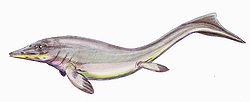Discovery and naming
The Baisesaurus holotype specimen, CUGW VH107, was discovered in 2018 in a layer of the Luolou Formation ( Triassospathodus symmetricus–T. homeri conodont assemblage zones [1] ) in the Nanpanjiang Basin of Zhebao Township in Baise, China. The specimen consists of assorted ribs, gastralia, a limb element (likely a radius), twelve vertebral centra, and seven neural arches. [2]
In 2022, Ren et al. described Baisesaurus robustus, a new genus and species of basal ichthyosauromorphs. The generic name, "Baisesaurus", combines a reference to the type locality in Baise, China, with the Greek "saurus", meaning "lizard". The specific name, "robustus", means "robust". [2]
Description and classification
Baisesaurus was likely at least 3 m (9.8 ft) long. It was more similar to Utatsusaurus than to any other ichthyosauromorph, with similar size and anatomical traits. It can be inferred from related animals that Baisesaurus was a strong swimmer with long, compact forelimb bones. [2]
Baisesaurus likely represents a basal member of the clade Ichthyosauromorpha, albeit outside of the clades Hupehsuchia or Nasorostra. In their 2022 description, Ren and colleagues explained that it may more precisely represent a member of the Ichthyopterygia, but such a classification is highly tentative. [2]
This page is based on this
Wikipedia article Text is available under the
CC BY-SA 4.0 license; additional terms may apply.
Images, videos and audio are available under their respective licenses.








